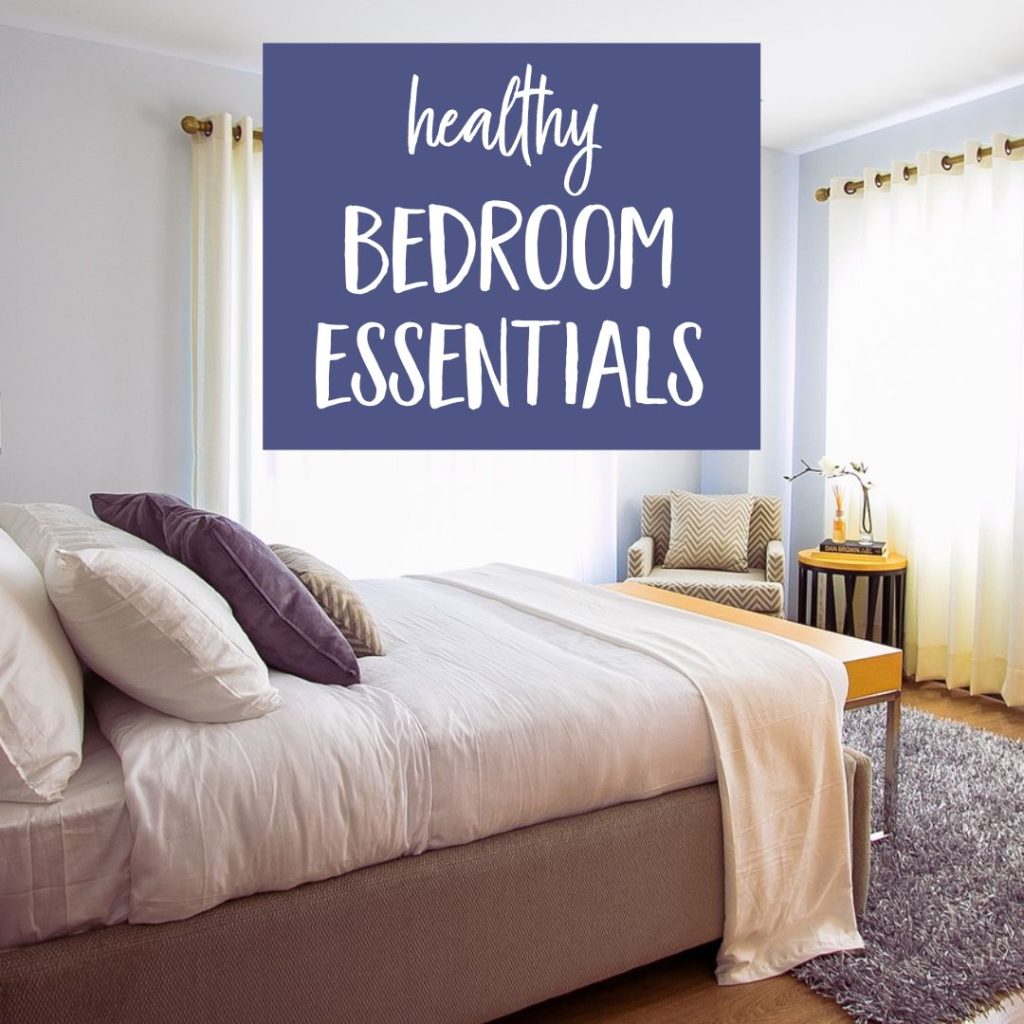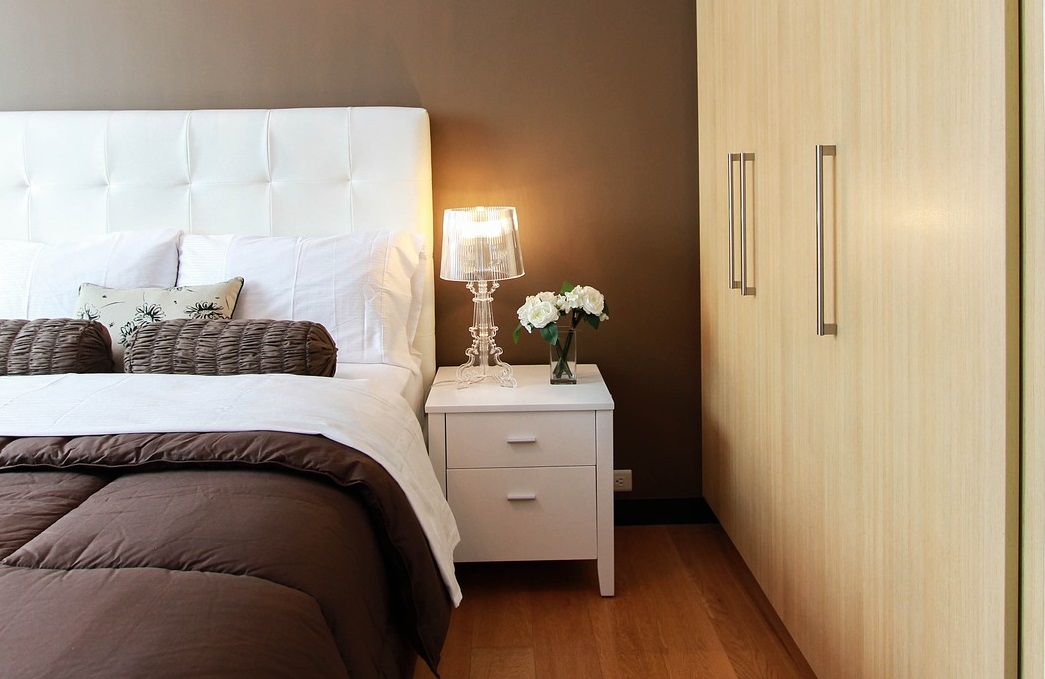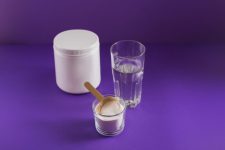How to Create a Healthy Bedroom for a Good Night’s Sleep
6 min read
Learn how to create a healthy bedroom with a non-toxic mattress and natural bedding – plus tips for managing air quality in the bedroom so you can get a good night’s sleep.

Imagine spending 8 hours in one place, with no expectations and nothing to do. Imagine breathing deeply and letting your body relax completely. Imagine drifting off into a peaceful, restful sleep.
Sounds heavenly and incredibly healthy, doesn’t it?
But here’s the wake-up call: Your bedroom might actually be a haven for chemicals that could be harming your health. Turns out those 8 luxurious hours might not be so healthy after all.
At Mindful Momma we only endorse products we’ve personally researched, tested, and honestly love. We may receive commissions from affiliate links in this article including Amazon Affiliates. Full Disclosure
Why a Healthy Bedroom Matters
There are a lot of sneaky ways that chemicals get into our bedrooms. They may be off-gassing from our mattress, or from the carpet or furniture in our bedrooms. Chemicals may be sprayed into the air from cleaning products or air fresheners. Toxins also end up in dust that hangs around longer than we would like to admit.
Keep in mind, this applies to kids bedrooms and baby nurseries as well as our own bedrooms. In fact, the impact of chemical exposure on babies and kids is even worse than for adults, given their developing bodies and immature immune systems.
Healthy Bedroom Checklist
I know all this can sound a bit scary – but I don’t want you to worry. You can significantly reduce your exposure to chemicals and create a healthy bedroom environment by working your way through this checklist.
Don’t worry about doing everything immediately – start with the small stuff and eventually make the more expensive changes when it makes sense for you. The goal is to create a healthy home that will improve your sleep quality and ensure your best health overall.
1.) Purify the Air
Because of all the ways toxins get into our homes, it’s no surprise that indoor air can get pretty polluted with chemicals. Pollutants like VOCs, dust mites, pet dander, mold, pollen and smoke can all reduce indoor air quality and have serious health effects from respiratory issues to cancer. Using an air purifier is one solution but there are other ways to keep indoor air fresh as well.
Some things you can do to purify the air in your bedroom:
- Open windows – getting polluted air out of the bedroom is part of the solution
- House plants – certain plants are known to filter air including English Ivy, Spider Plants and Peace Lily
- Salt lamps – salt purifies air by attracting water vapor that may contain mold or other allergens. I have a small night light salt lamp in my bedroom but tabletop salt lamps are popular too
- Air purifier – use an air purifier with a HEPA filter
- Air filters – replace air filters for your furnace/air conditioner frequently. Get filters that are rated MERV 10 or higher (MERV rates a filter’s ability to capture particles)
- Essential oil diffuser – diffusers are a great alternative to commercial air fresheners. Many essential oils are anti-bacterial.

RELATED: 4 Good Reasons to Buy Natural, Non-Toxic Products for Home & Life
2.) Sleep on a Non-Toxic Mattress
Most mattresses on the market are filled with toxic chemicals including flame retardants, polyurethane foam and PVC plastic. These mattress chemicals are linked to health problems like hormone disruption, respiratory irritation and even cancer.
If you want to get into the nitty gritty about mattresses – head over to my post about how to find the best natural and organic mattress brands. Meanwhile, I’ll tell you that I sleep on a firm Naturepedic mattress every night and love it.
Some things to look for in a non-toxic mattress:
- GOTS certified organic cotton & wool, and GOLS certified organic latex
- Latex should be natural latex rubber, not synthetic latex
- No chemical flame retardant added
- For accident protection, look for safe mattress covers made from polyurethane laminate (PUL) fabric or polyethylene instead of PVC or vinyl
Tip: If a new mattress is not in your future, consider putting a natural wool, latex or cotton mattress topper on top of your old mattress instead.
RELATED: Affordable Non-Toxic Mattresses
3.) Use Natural Fiber Bedding
Since we spend one-third of our lives in bed, we should make sure the bedding we are sleeping in is not only cozy, but safe. Conventional bed-sheets often contain chemical residues – either from pesticides sprayed on cotton or from plastics used in polyester.
Some sheets are also treated with chemicals to make them stain or wrinkle resistant. Pillows are often synthetic and are sometimes treated with chemical flame retardants.
Here are some better bedding alternatives:
- Organic cotton sheets – I’ve purchased organic sheet sets at Target and they are perfectly serviceable. If you want super nice organic cotton sheets, check out Coyuchi.
- Bamboo fiber sheets – Renewable bamboo is naturally temperature regulating. Target has an affordable bamboo rayon sheet set. And I’m in love with my bamboo sheets from Cariloha.
- Wool & organic cotton pillows – We love our natural wool filled pillows from Moss Envy (made in Minnesota!) The cover is organic cotton and these are the best pillows I’ve personally used.
- Latex & Kapok pillows – We also love our Green Pillows from Avocado. They are a mix of GOLS organic certified latex and GOTS organic certified Kapok fill, wrapped in a GOTS organic certified cotton cover. You can adjust the amount of fill which is really helpful.
- Read my primer on how to choose a non-toxic pillow to suit your needs.
Read my Guide to Natural & Organic Bedding here!
Tip: If your regular sheets are well-worn and frequently washed, they don’t necessarily need to be replaced. When it comes time for a new sheet set, consider going organic.

4.) Clean with Eco-Friendly Cleaning Products
When we grab our cleaning products we expect them to well….clean. Little do we know, many cleaning products actually impart toxic chemicals into the air we breathe – in the form of VOCs (volatile organic compounds).
Use these safe cleaning products in your bedroom:
Tip: To freshen up sheets I spray them with ECOS Breeze from Earth Friendly Products. It smells wonderfully fresh but is eco-friendly and non-toxic!
5.) Buy Non Toxic Bedroom Furniture
Sadly, furniture and carpet are other ways that toxic chemicals sneak into our bedrooms. Most upholstered furniture and cushions are made with toxic flame retardant chemicals, and many also contain stain or water repellents.
These chemicals off-gas and accumulate in dust in your home. Also avoid furniture made from plywood or particle board, which can emit formaldehyde fumes.
Here’s what to look for in bedroom furniture:
- Upholstered furniture assembled using natural latex foam or low-VOC certified foam
- Label reading “The upholstery materials in this product contain NO added flame retardant chemicals.”
- A non toxic bed, dresser and other solid wood furniture made with water based glues and that are FSC-certified
- Bedroom furniture painted with low-VOC paints

6.) Use Non Toxic Carpet and Floor Coverings
Wall-to-wall carpeting is a hotbed of synthetic chemicals, chemical treatments (stain resistant and water proofing) and glues, all of which can be associated with respiratory issues, skin irritations and even cancer. Other floor covers may off-gas chemicals from glues and adhesives.
Here’s what to look for in floor coverings:
- Wool carpet – a natural, renewable fiber that is biodegradable and long-lasting
- Greenguard or Green Label Plus certified carpet – these have lower VOCs than traditional carpet
- Low or zero VOC glues and adhesives used to attach flooring.
Resources for Non Toxic Bedroom Furniture & Carpet
Here are some of the companies I’ve found that sell safe and non toxic furniture for the bedroom including healthy beds, non toxic nightstands and more. I’ve also included some resources for non-toxic carpet brands.
Note: You’ll still need to ask a lot of questions – but these companies are known for having some non-toxic, eco-friendly offerings.
What have you done so far to create a healthy bedroom? What are you still working on?

RELATED: Eco-Friendly Pajama Roundup







